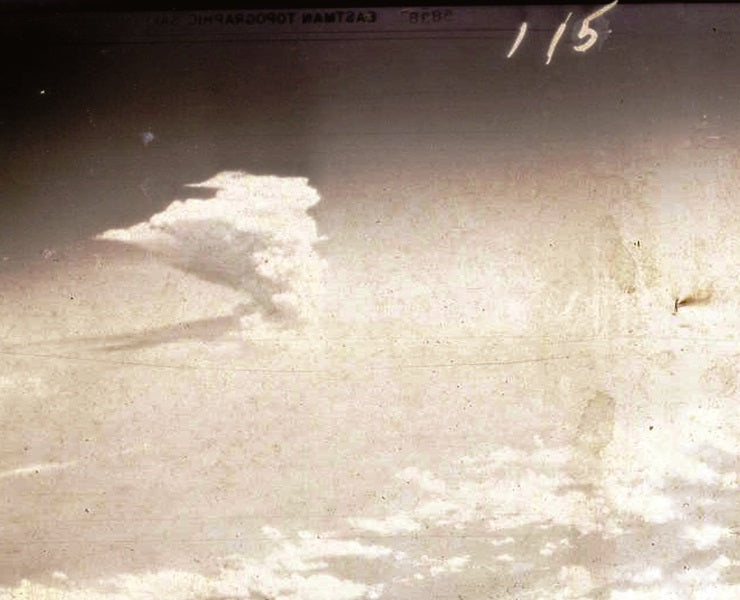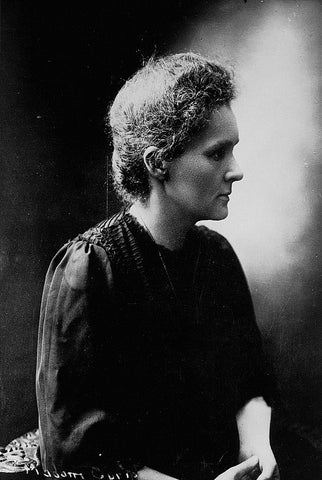
The Lab Coats That Built The Atomic Bombs
History was forever changed by men and women in white lab coats on the night of July 15-16, 1945, in the desert of Los Alamos, New Mexico.
It was the night of the world's first atomic bomb test, nicknamed the "Gadget." A site, codenamed Trinity, in a barren valley near Alamogordo, New Mexico, 200 miles south of Los Alamos, had been chosen. The moment represented make or break for the Manhattan Project, the top-secret plan by the United States of America to produce a nuclear weapon. The project was kicked off in 1939 by a letter from none other than Albert Einstein and physicist Leo Szilárd to President Franklin D. Roosevelt. The duo warned Roosevelt that Nazi Germany was beginning work on a superweapon, unlike anything the world had ever witnessed before. The Manhattan Project was officially authorized in 1942. It would go on to employ thousands of lab coat professionals, including the cream of the country’s elite scientists.
For example, watching the test from 10,000 yards away that night in the deserts of New Mexico were reigning, and future Nobelists such as Enrico Fermi, John von Neumann, Eugene Wigner, Hans Bethe, Richard Feynman, and the project's scientific director, J. Robert Oppenheimer. The who’s who of lab coat wearers indeed!

Although at this point Nazi Germany had been defeated and the European Theatre had come to a close, battles still raged across the Pacific, with the Imperial Army of Japan digging down deep for the final defense of their homeland. America was eager to avoid a ground invasion of Japan’s mainland, with some generals fearing casualties of up to one million US soldiers if forced to do so.
I Am Become Death
When Gadget detonated at 5:29 am, a brilliant flash of white light filled the sky, morphing into a rapidly billowing orange fireball that dissolved skyward and rose to 41,000 feet. The bomb unleashed terrifying power. The lab coat community and the world had forever crossed the nuclear threshold. Some described the blast as “a light not of this world but of many suns in one."
Gadget spewed a level of destructive power previously unknown in the existence of humanity, releasing the equivalent energy of 21,000 tons of TNT and a fireball that measured 2,000 feet in diameter. Moreover, the heat from the bomb evaporated the steel tower that the bomb had been mounted on, leaving a crater five feet deep by 30 feet wide. The men in lab coats wondered what had they created.
Browse Our Lab Coat Collection Now
For example, astounded by the power that he had witnessed ,Oppenheimer famously quoted from Hindu scripture, the Bhagavad Gita: "Now I am become death, the destroyer of worlds."
Scientific discoveries over several centuries by numerous lab coat wearers had eventually led up to this monumental point of splitting the nucleus of an atom. In 1789, German scientist Martin Klaproth made one of the first dents in the mystery when he discovered what he would call uranium. As we covered in one of our Legends of the Lab Coat series, Marie Curie next uncovered that uranium was a radioactive element in the late 1800s. This discovery of radioactivity in elements forever altered how atomic science was approached. British physicist Ernest Rutherford used this analysis as a springboard in 1911. He built an atom model where low-mass electrons orbited a charged nucleus that contained the bulk of the atom's mass.

The Race To The Bomb
By the 1930s, Hungarian-German physicist Leo Szilard developed the possibility of a nuclear chain reaction. In 1934, Italian physicist Enrico Fermi accidentally split neutrons within uranium when experimenting in his own lab. Soon after, Austrian-Swedish physicist Lise Meitner, working with German chemist Otto Hahn, conquered the successful fission of uranium. The lab coat community was certainly moving at a hectic pace!
Meitner's findings became the key to unlocking the remaining pieces of the puzzle in the development of nuclear weapons. But as the world once again geared up for war in 1930s Europe, it seemed that the Germans held the advantage to harnessing the devastation of nuclear power. However, ironically, the growing hostility and persecution of Jews by Nazi Germany caused many of the country’s top lab coat wearers involved in this research to flee the country. For instance, while Hahn chose to remain in Germany and continued to develop his research throughout World War II, scientists across Europe steadily ran. Szilard left for the United States in 1938. Similarly, Fermi left Europe in 1938 to escape growing Fascism in Italy.
When Szilard learned of Hahn and Meitner's work on nuclear fission in New York City in 1939, he immediately recognized the significance of the moment.
Browse Our Lab Coat Collection Now
In July 1939, he contacted the legendary Jewish German theoretical physicist Albert Einstein who lived in New York. The duo discussed German advances in nuclear development and drafted their famous letter to US President Franklin D. Roosevelt. In the letter, dated August 2, 1939, they warned: "This new phenomenon would also lead to the construction of bombs, and it is conceivable—though much less certain—that potent bombs of a new type may thus be constructed." Once the letter reached Roosevelt’s desk in October, he immediately sprang into action. He sanctioned an Advisory Committee on Uranium, which held its first meeting on October 21, 1939.
The Manhattan Project that would lead to atomic weapons being dropped over Japanese cities forever changed the global landscape. Let’s explore some of the most brilliant minds and lab coat wearers that were instrumental in turning the theory of atomic weapons into a reality.

Robert Oppenheimer
Oppenheimer was an American theoretical physicist, widely renowned as the father of the atomic bomb. Born in 1904, his intelligence was evident from a young age. He was invited to lecture at the New York Mineralogical Club at the age of 12. He graduated from Harvard with a degree in chemistry in just three years. Oppenheimer pursued a physics degree under Max Born, a highly distinguished theoretical physics professor from Germany. After receiving his doctorate in 1927, Oppenheimer worked as a physicist until in 1942, Oppenheimer was chosen by the United States Army to manage the Manhattan Project with a budget of $2 million. Oppenheimer later claimed that developing a solid method for implosion and purifying plutonium was the most draining aspect of the Manhattan Project. Oppenheimer's understanding of fast neutrons is credited with helping the Manhattan Project achieve its goal in 1945.
Leo Szilard
Leo Szilard was a Hungarian physicist who worked closely with Einstein to draft the aforementioned Einstein Letter to President Roosevelt. He earned a degree in physics at the University of Berlin, alongside Einstein. Szilard did most of his early work and research in Germany. But as the Nazi Party began to gain control over Germany, Szilard, who was Jewish, emigrated. Szilard was one of the first to recognize the dangers of harnessing atomic energy. He was terrified that Nazi Germany would win the race to develop nuclear weapons and release them on the world unchecked. Szilard became an integral part of the Manhattan Project. After a thorough investigation of uranium fission, Szilard partnered with Enrico Fermi and his engineers to build the first self-sustaining nuclear chain reaction. Accomplishing this task in 1942 was an essential component for producing a functional atomic weapon.
Browse Our Lab Coat Collection Now
Klaus Fuchs
Klaus Fuchs, a German theoretical physicist, was a spy working for the Soviet Union who had embedded himself within the Manhattan Project. Again, following the rise of Nazi Germany, Fuchs left Germany. He became a British citizen in 1942 and was selected by the British as part of their delegation of lab coats to take part in the Manhattan Project. However, during his time on the project, Fuchs delivered atomic secrets to the Soviets. That said, despite this conceit, Fuchs contributed many essential theories to the atomic bomb development. This included helping develop the means needed to implode the critical fissionable core within the first atom bomb designs. His work on "Fat Man," the bomb dropped over Nagasaki, was highly praised by the United States Army. Fuchs had been present at the Trinity Test in July 1945. It is estimated that the information that Fuchs passed along to the Soviets allowed them to build their atomic bomb one year sooner than expected. Uncovered for his treachery in 1949, Fuch was sentenced to 14 years in prison, serving nine.
Ernest O. Lawrence
Ernest Lawrence was an American-born nuclear physicist who participated in the Manhattan Project. Lawrence received his doctorate in 1928 from Berkeley, California. Before his selection for the Manhattan Project, Lawrence was focused on advancements in nuclear physics. It was in this pursuit that Lawrence invented the cyclotron in 1929. This device accommodated the acceleration of atomic particles to velocities high enough to disintegrate atoms. This formed new elements without using high voltage currents and proved critical in the production of the nuclear bomb. After World War II, Lawrence dedicated much of his time trying to have atomic bomb testing suspended.
Hans Bethe
Hans Bethe was born in Strasbourg, Alsace-Lorraine in 1906. He was the Chief of Theoretical Division for the Manhattan Project after leaving Germany following the rise to power of the Nazis. Bethe discovered several crucial aspects of physics that made the atomic bomb possible and is remembered as one of his generation's most influential theoretical physicists. For instance, he identified that nuclear fusion is the reaction in the core of giant stars. This chemical process gives off heat and energy. Using this theory, he hypothesized multiple ways that hydrogen nuclei could be fused with helium nuclei, which proved to be fundamentally important to completing the atomic bomb. Bethe’s other main contribution to the Manhattan Project was writing a formula required for calculating the explosive yield of an atomic bomb.
Browse Our Lab Coat Collection Now
Enrico Fermi
Enrico Fermi was an Italian scientist who worked on the Manhattan Project. He was a physicist who created the world's first nuclear reactor, the Chicago Pile-1. In 1938, Fermi had been awarded the Nobel Prize in Physics for his work on induced radioactivity by neutron bombardment and the discovery of trans-uranium elements. Fermi filed several patents related to nuclear power with his colleagues, all of which were taken over by the US government.
Glenn Seaborg
Glenn Seaborg was an American-born chemist and earned his Ph.D. at the University of California, Berkeley. In 1941, together with Edwin McMillan, Seaborg discovered plutonium, a critical component of nuclear weapon technology. Following this discovery, Seaborg was onboarded to the Manhattan Project. He managed the team that handled plutonium work at the University of Chicago's Metallurgical Laboratory. This group was in charge of producing the plutonium-239 required to build the "Fat Man" bomb. He was also able to develop a valid method of separating, concentrating, and isolating plutonium.
Albert Einstein
Einstein never worked directly on the atomic bomb. His famous equation E=mc2 explains the energy released in an atomic bomb. However, his letter to Roosevelt in 1939 was instrumental in leading to the formation of the Manhattan Project. Einstein eventually came to regret writing his letter to Roosevelt. In an interview with Newsweek magazine, he said that "had I known that the Germans would not succeed in developing an atomic bomb, I would have done nothing."